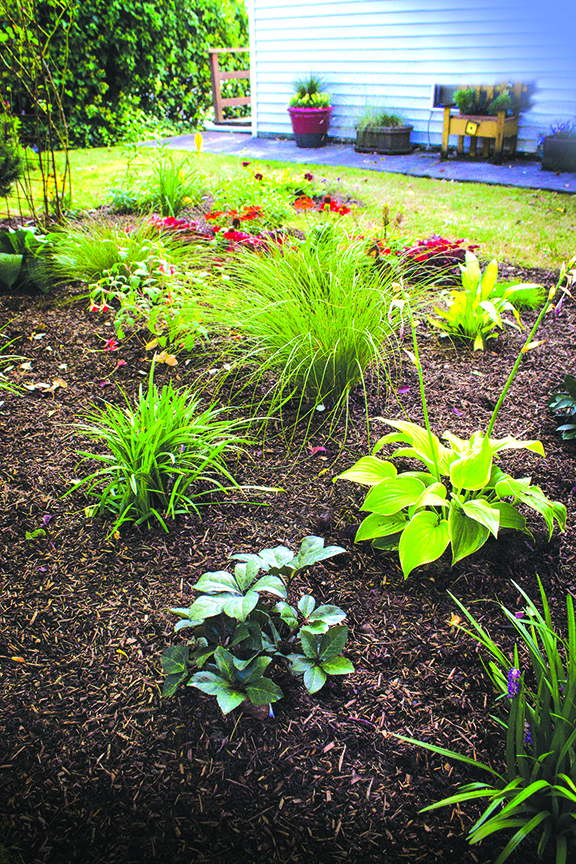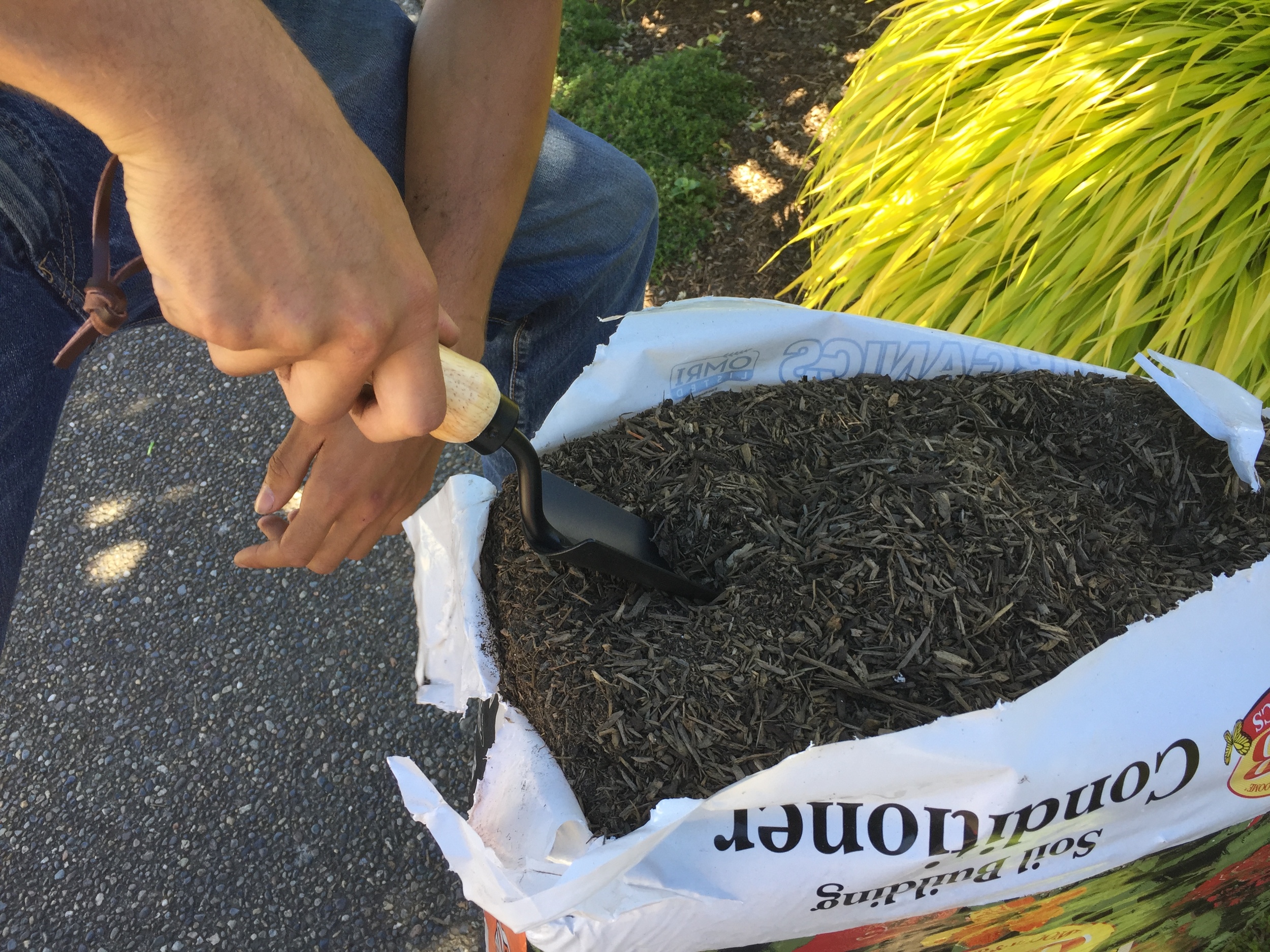If you hang around Swansons long enough, you’ll hear us extol the benefits of “compost” and “mulch,” often in the same sentence. You’ll hear them both as nouns and verbs. Are they the same thing? Not exactly, but their uses and benefits to your garden are closely related.
Here, we’ll talk about various types of mulch and why and how we use them.
What is mulch and why should I add it?
Compost is a material made of decomposing organic matter.
Mulch is, essentially, a function, referring to any protective covering put on the surface of soil.
Mulch serves to conserve moisture in the soil, improve nutrients and soil structure, deter weed growth and help control erosion. The verb, to mulch, is to apply mulch to the ground surface, as in “mulch your beds with leaves, bark or compost.” Another common term for mulching is “top dressing.”
Mulching may be achieved by any one of several materials. Mulch can be organic (compost, leaves, bark, cardboard, newspapers, etc.) or inorganic (rocks, gravel, plastic, weed barrier fabric, etc.)
Which material is best?
In most situations, we strongly prefer organic to inorganic, as those materials allow water and air to penetrate, and they break down to actually feed the plant roots.
Inorganic types might be fine for a temporary cover, unique plants (such as succulents in gravel) or other unique situations where organic mulch might not work. Some people prefer inorganic just for appearance or for the ultimate in low-maintenance (doesn’t decompose for a long time), but those materials do little for your plants’ health.
The commercial mulch we recommend the most is G&B Organics® Soil Building Conditioner, which is coarse enough for weed deterrent and erosion control, but fine enough to enhance the soil. It’s a compost-type product that makes a great mulch. It’s also a great compost material to mix in for planting as a soil amendment. Hence, the confusion when we mention using "compost" as "mulch"!
Arguably, the best mulch for any given plant is that which most closely resembles its own dead material. In native settings, plants are mulched by what they shed themselves or by overhead trees and larger plants. This is what they've adapted to.
So the healthiest mulch for a bed of mostly perennials would be composted fine plant parts, grasses or small leaves (our bagged compost/conditioner contains these materials) rather than coarse bark, wood chips or inorganic materials. Bark or chips are fine for large areas of woody trees and shrubs, but not as friendly to herbaceous plants (such as perennials) for the long term.
One exception to using the plant’s own material is in the case of fruit trees, berry shrubs, or other plants where insect pests or diseases is a primary concern. Insect eggs and disease spores often winter over on fallen leaves and fruits, so it’s wise to remove these after they fall, and mulch with compost or other types of organic matter.
There are also special situations, such as plants which struggle with our wet winters. We sometimes recommend mulching these with coarse leaves, gravel or rocks to shed or drain water away from the plants. And some heat-loving vegetables benefit from black plastic or other methods to warm the soil. But most plants benefit from compost or other mulch similar to themselves.
Mulching in the native forest: no human assistance required!
credit: geograph.org.uk
Do I have to mulch my entire property every year for the rest of my life?
Not unless you own acres of exposed dirt with no plans to actually plant it with anything!
Think of mulch as a temporary cover until the plants spread enough to create their own mulch. In a mature landscape, the plants have (ideally) filled in sufficiently to shade out weeds and replenished the mulch cover each year with what they shed. So there should be little need for adding extra mulch to those areas.
However, every garden or landscape is constantly changing. There will be plants to cut back or replace, and thus, newly-exposed soil areas which can be mulched until the plants fill in again. Remember: any bare soil will eventually be colonized by something. Thoughtful planting and mulching lets you decide what grows there.
In the vegetable garden, which is typically tilled and replanted every year, mulching open soil or spaces between plants as they grow can make quite a difference.
Mulch can enhance your vegetable garden, protecting roots and keeping moisture in the soil.
credit: University of Minnesota Extension
When should I mulch?
Anytime the soil may be exposed and drying out is a good time to mulch because mulch helps keep moisture in the soil. Experienced gardeners often apply some in the early spring and some in the late fall. The extra benefit of spring is in slowing weed growth and adding nutrients to the soil. Fall mulching also helps protect soil and roots from harsh freezes.
How should I mulch?
Apply mulch by dropping small piles with a shovel between groups of plants, then spreading it out around and under them with a shovel, rake, hand tool or gloved hands. Again, avoid heaping it up against trunks of most plants, especially trees and shrubs. Laying materials such as cardboard or weed barrier will require some cutting and fitting.
Laying mulch in shrub beds.
credit: homeconstructionimprovement.com
How deep do I mulch?
How deep depends on types of plants and how often you mulch or maintain your plants. For new plantings or bed that hasn’t been mulched in a few years, 2-3 inches is a good average, but if you have smaller plants or are working in the garden often, you might only need an inch or two.
A large area of trees and shrubs might tolerate a deeper layer of coarser mulch. In any case, it’s better for the plants to add thinner layers once or twice a year than one super-thick layer every few years. Let the soil “breathe!”
What happens if I over-mulch?
The decomposing of the mulch and moist environment can allow crown rot and other plant diseases to take hold. It can also happen if mulch is trapping moisture against woody trunks or other plant tissue. Keep it over roots but a couple of inches away from trunks.
So now you’re covered! Or, rather, your garden is. Never hesitate to ask us more questions about mulching and other tricks for healthy, successful gardens.
You can find a concise discussion of mulch and compost on the care sheet, ‘Gardening 101,’ on the NW Gardening Tips page or our website.







